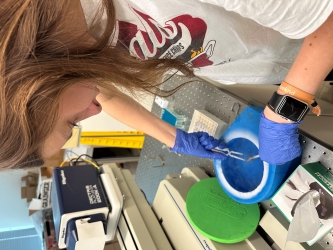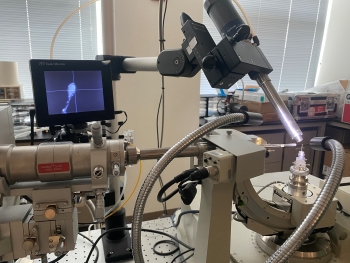Hi! I’m Cameron Reimers ‘26, and I worked for Anschutz Medical Labs at the University of Colorado in Denver on drug development for Tuberculosis (Tb). My research focused primarily on X-ray crystallography, which is a way to identify molecular structure of an unknown compound or protein. I had a very positive experience both in the lab and outside, exploring Colorado.
Tuberculosis (Tb) is the top single agent infectious disease killer in the world. Over 1.3 million people died from Tb in 2022, and there has only been one new drug developed since the 1960s. Antibiotic resistance is a growing problem, so my research was rooted in developing a new Tb drug. My mentor, Dr. Nathan Wlodarchak, had done some previous work on finding compounds that inhibited phosphatase, an important enzyme in Tb bacteria. One particular compound, “compound 09,” worked really well with shutting down Tb. The trouble is, the structure of the drug bound to its target was unknown, so that was my task.
I spent the summer growing crystals made of the drug and target. Once I had crystals, I harvested and got them ready for X-ray analysis. X-rays shoot at the crystals, and the way that the rays diffract tells us the placement of the atoms.
In the lab, I also learned from some mistakes I made along the way. While preparing a crystal tray, I used a robot in the lab to shake my tray in order to uniformly mix the compounds. While attending to other matters, I forgot about my tray and left the robot running several hours after the work day was over. When I realized my mistake, I initially started to panic. This was an expensive machine, so what if I broke it? How was I going to tell Dr. Wlodarchak? I composed myself, alerted him of my mistake, and asked him what I could do to ensure the machinery would not break. He wrote back that the robot would most likely be ok, and that there wasn’t much we could do before the next morning. I set my alarm early and arrived at the lab around 7am to check on the machine as soon as the building was open. The machine ended up being fine, but I had to redo my experiment. I learned a lot about how to professionally handle and own up to mistakes that I cause in the workplace. What matters is how we respond to hardships. I learned to give myself grace and quickly respond when problems arise.
Two examples of my drug crystals of compound 09 and phosphatase under the microscope!
 Freezing my drug crystals in liquid nitrogen in order to prepare for X-Ray diffraction. The liquid nitrogen is 100 Kelvin, or around -300 degrees Fahrenheit!
Freezing my drug crystals in liquid nitrogen in order to prepare for X-Ray diffraction. The liquid nitrogen is 100 Kelvin, or around -300 degrees Fahrenheit! The X-Ray diffraction machine. The screen is a camera that shows the crystals, while the tubes pointing at the crystal keep it cold.
The X-Ray diffraction machine. The screen is a camera that shows the crystals, while the tubes pointing at the crystal keep it cold.When I was not in the lab, I spent my time outdoors hiking and exploring the mountains. One of the highlights was hiking my first “14ers,” a term used to describe mountains whose summit is above 14,000 ft. I hiked Grays Peak and Torreys Peak on the same day, and although challenging, the views at the top were worth it. It took about 7.5 hours to do both, and I gained around 4,000 ft of elevation on the hike. Hopefully, I’ll come back to Colorado soon and do more. There is a 14er called Cameron Mountain, so that one is first on my list because of its awesome name. Hiking was very rewarding after spending work days inside. I got lots of sun and exercise while spending some time getting to know myself in nature.
Pictures from Grays Summit and Torreys Summit! It was around 40 degrees but I was sweaty from the hiking.
I will forever be thankful for my research experience at Anschutz Medical Campus. It challenged me academically, and I learned so many new lab skills that I will carry with me throughout my time left at Cornell and my future as a research scientist. I definitely found a new passion in X-ray crystallography and hope to do more work with it in the future even if it is a niche topic. I would also like to do more drug development. These concepts are mainly explored in graduate programs, so finding a school with good programs in both departments would be ideal. I can’t wait to see where next summer takes me and what I do next. Research is my passion, and there is so much left to discover.